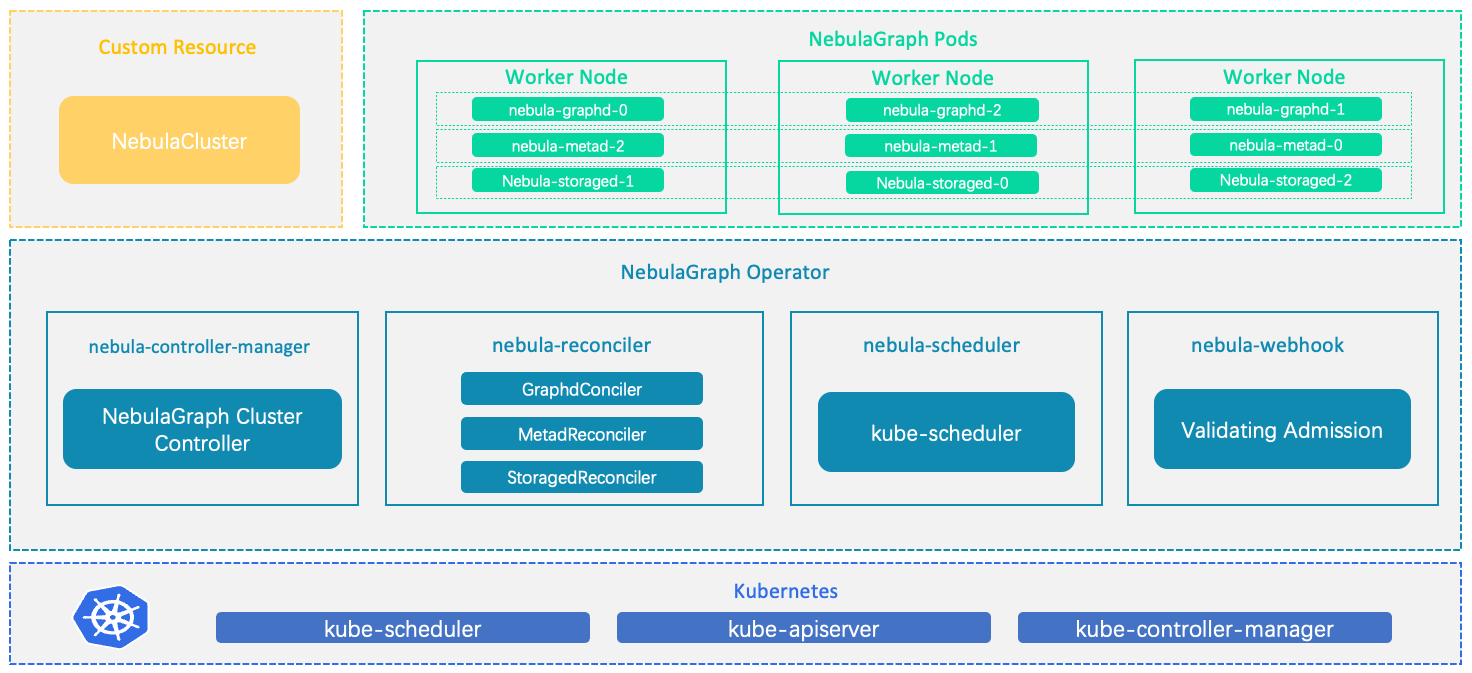What is NebulaGraph Operator¶
Concept¶
NebulaGraph Operator is a tool to automate the deployment, operation, and maintenance of NebulaGraph clusters on Kubernetes. Building upon the excellent scalability mechanism of Kubernetes, NebulaGraph introduced its operation and maintenance knowledge into the Kubernetes system, which makes NebulaGraph a real cloud-native graph database.

How it works¶
For resource types that do not exist within Kubernetes, you can register them by adding custom API objects. The common way is to use the CustomResourceDefinition.
NebulaGraph Operator abstracts the deployment management of NebulaGraph clusters as a CRD. By combining multiple built-in API objects including StatefulSet, Service, and ConfigMap, the routine management and maintenance of a NebulaGraph cluster are coded as a control loop in the Kubernetes system. When a CR instance is submitted, NebulaGraph Operator drives database clusters to the final state according to the control process.
Features¶
The following features are already available in NebulaGraph Operator:
- Deploy and uninstall clusters: NebulaGraph Operator simplifies the process of deploying and uninstalling clusters for users. NebulaGraph Operator allows you to quickly create, update, or delete a NebulaGraph cluster by simply providing the corresponding CR file. For more information, see Deploy NebulaGraph Clusters with Kubectl or Deploy NebulaGraph Clusters with Helm.
- Scale clusters: NebulaGraph Operator calls NebulaGraph's native scaling interfaces in a control loop to implement the scaling logic. You can simply perform scaling operations with YAML configurations and ensure the stability of data. For more information, see Scale clusters with Kubectl or Scale clusters with Helm.
- Cluster Upgrade: NebulaGraph Operator supports cluster upgrading from version 3.0.0 to version 3.4.0.
- Backup and Recovery:NebulaGraph supports data backup and recovery. Users can use NebulaGraph Operator to backup the data of the NebulaGraph cluster to storage services that are compatible with the S3 protocol, and can also restore data to the cluster from the storage service. For details, see Backup and restore using NebulaGraph Operator.
- Self-Healing: NebulaGraph Operator calls interfaces provided by NebulaGraph clusters to dynamically sense cluster service status. Once an exception is detected, NebulaGraph Operator performs fault tolerance. For more information, see Self-Healing.
- Balance Scheduling: Based on the scheduler extension interface, the scheduler provided by NebulaGraph Operator evenly distributes Pods in a NebulaGraph cluster across all nodes.
Limitations¶
Version limitations¶
NebulaGraph Operator does not support the v1.x version of NebulaGraph. NebulaGraph Operator version and the corresponding NebulaGraph version are as follows:
| NebulaGraph | NebulaGraph Operator |
|---|---|
| 3.0.0 ~ 3.4.1 | 1.3.0, 1.4.0 ~ 1.4.2 |
| 3.0.0 ~ 3.3.x | 1.0.0, 1.1.0, 1.2.0 |
| 2.5.x ~ 2.6.x | 0.9.0 |
| 2.5.x | 0.8.0 |
Legacy version compatibility
- The 1.x version NebulaGraph Operator is not compatible with NebulaGraph of version below v3.x.
- Starting from NebulaGraph Operator 0.9.0, logs and data are stored separately. Using NebulaGraph Operator 0.9.0 or later versions to manage a NebulaGraph 2.5.x cluster created with Operator 0.8.0 can cause compatibility issues. You can backup the data of the NebulaGraph 2.5.x cluster and then create a 2.6.x cluster with Operator 0.9.0.
Feature limitations¶
The NebulaGraph Operator scaling feature is only available for the Enterprise Edition of NebulaGraph clusters and does not support scaling the Community Edition version of NebulaGraph clusters.